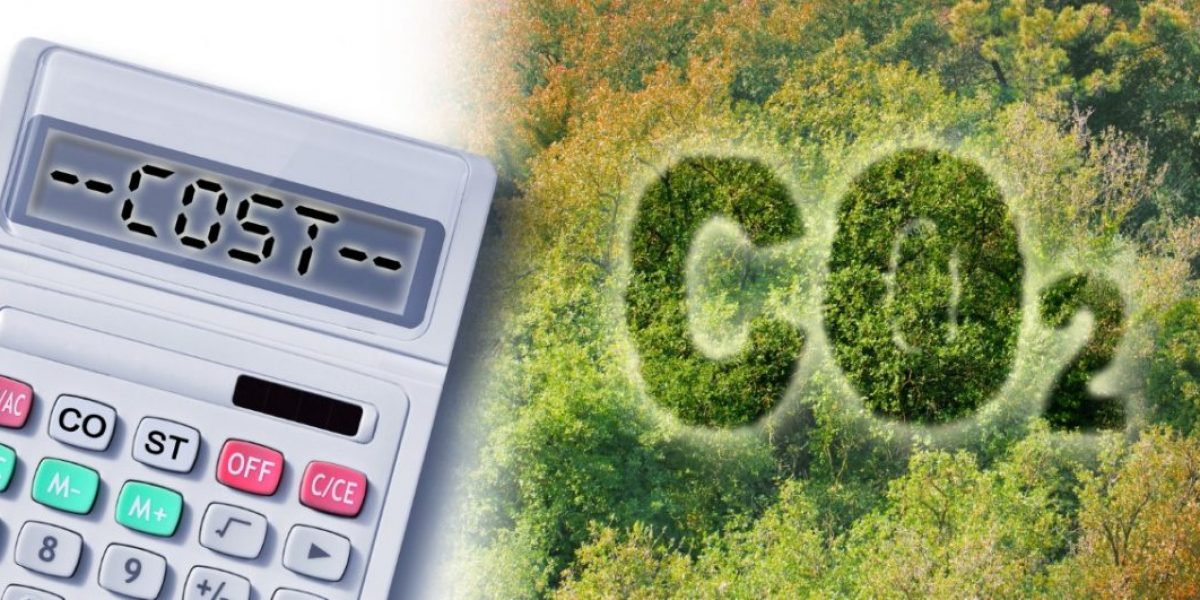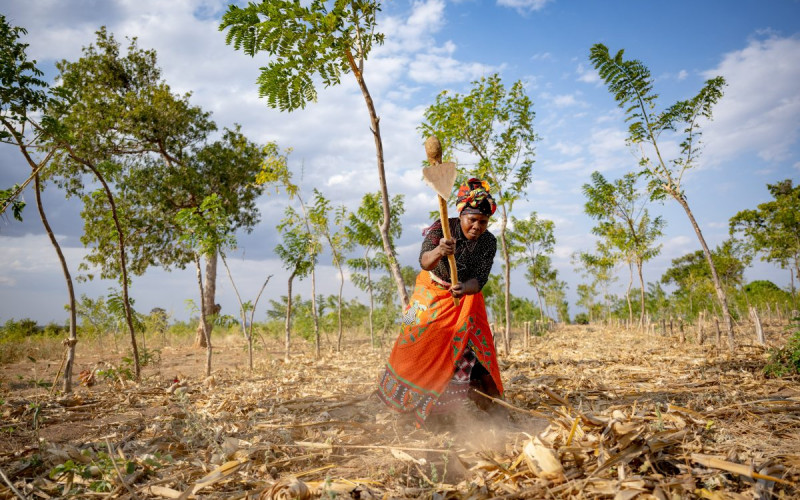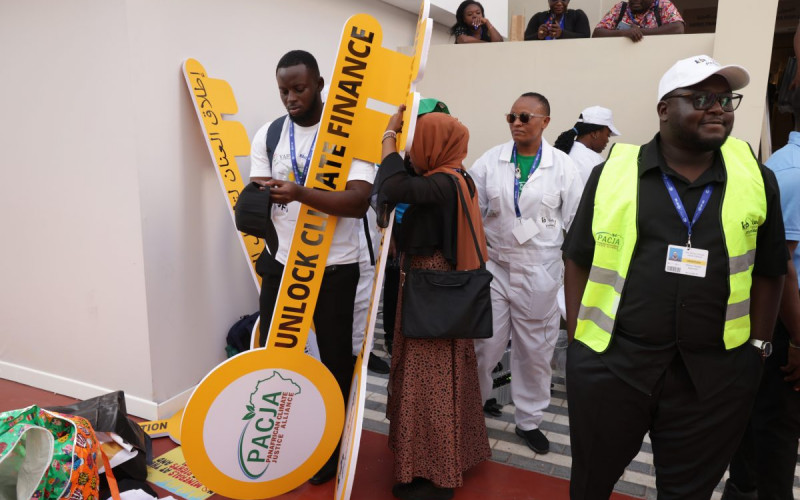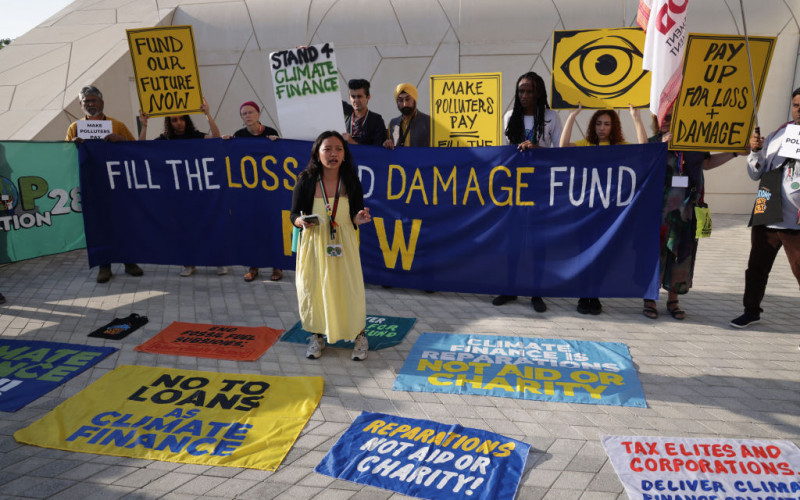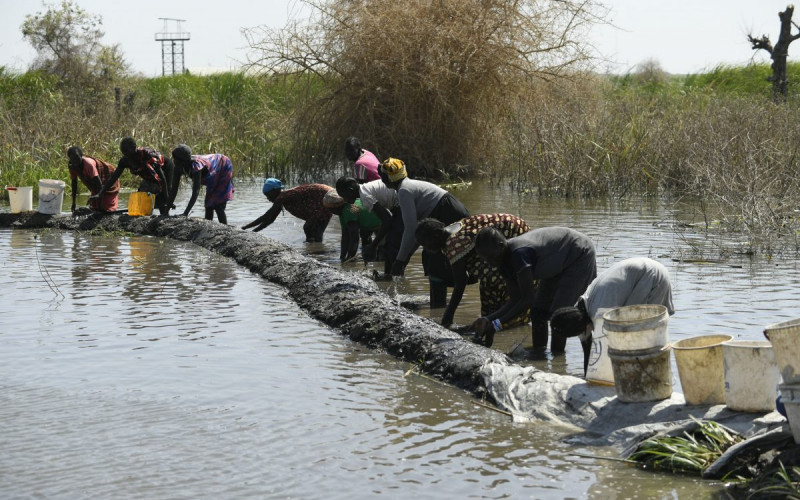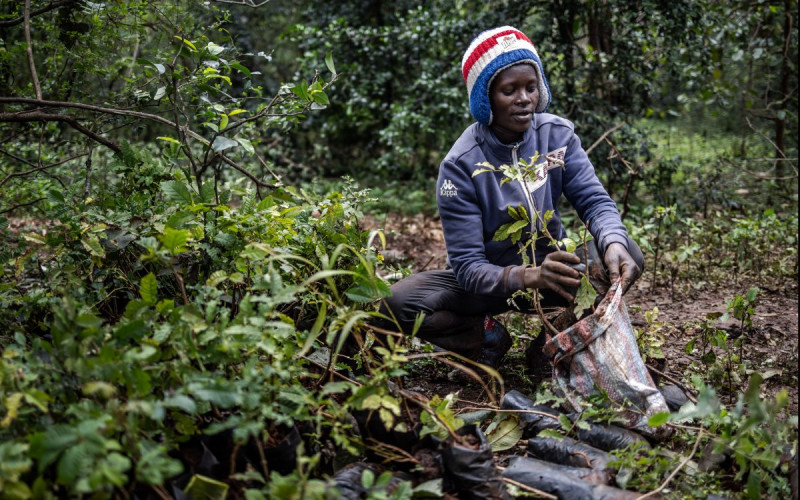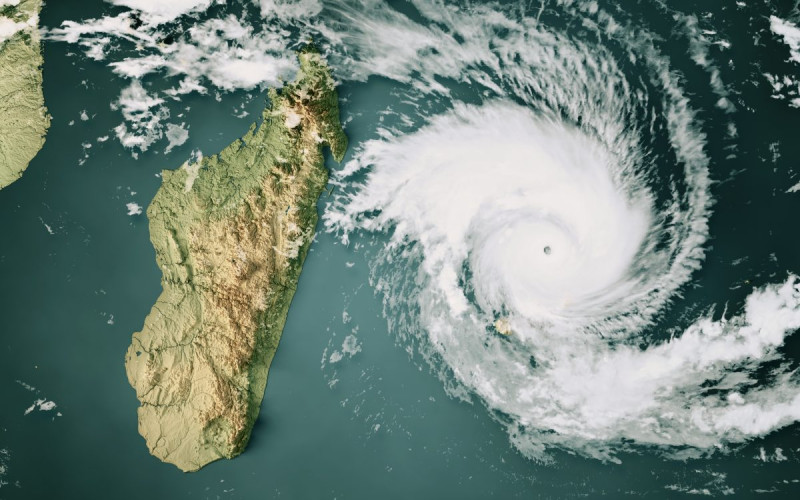Recommendations
- The G20 should help facilitate innovative private financing of Africa’s climate change interventions.
- The G20 should help with mobilising public and institutional funds for African countries through debt-for climate swaps and similar instruments.
- More ‘just transition partnerships’ ought to be explored and supported for African countries that need them to fast-track implementation of their NDC commitments.
- With G20 members among the crucial parties expected to contribute to the loss and damage fund, the G20 as a platform must lead the process of its establishment and ensure members’ commitment and actual financial contributions to the fund.
Executive Summary
Climate finance remains a major constraint to Africa’s aspirations of a sustainable and resilient economy. With traditional financing avenues offering limited access to funds, innovative ways of climate financing have become essential for Africa. G20 members, through the Sustainable Finance Working Group and the Bali declaration, have shown intent to mobilise sustainable finance for developing countries and can therefore play an important role in encouraging innovative financing of green investments in Africa. Among other things, the G20 can play a role in the development of green finance taxonomies in Africa, promote risk sharing in sustainable finance, assist in the development of carbon pricing, and help promote green financing in local markets. It can also provide more support to Africa by mobilising public and institutional funds through debt-for-climate swaps and similar instruments, as well as putting aside funds for more just transition partnerships, loss and damage, and emissions reduction in the AFOLU sectors.
Introduction
COP27 has concluded with some progress having been made on issues that matter most to Africa. A breakthrough on loss and damage negotiations has been achieved (albeit limited), an additional $230 million has been pledged for adaptation financing and a work programme to promote climate technology solutions in developing countries was launched, among other achievements. While these are steps in the right direction, Africa’s financial need to ensure meaningful progress towards climate change mitigation and adaptation remains unmet and will continue to be a major issue going forward. The main challenge for African governments is balancing short-term needs with mid- to long-term outlooks on returns on climate investments, debt, global risks and opportunities. This requires altered concepts of finance for development that is responsive to and appropriate for a rapidly changing environment beset by a growing debt burden and a challenging geopolitical and economic outlook.
The mobilising demands of African countries to address their climate needs and fulfil their nationally determined contributions commitments necessitates innovative global approaches towards resource mobilisation. For this, the role of the G20 is instrumental. Through the Sustainable Finance Working Group, the G20 seeks to mobilise sustainable finance by identifying institutional and market barriers, developing options to overcome such barriers, and contributing to a better alignment of the international financial system to the internationally agreed climate objectives.
This paper explores Africa’s challenges with the international finance architecture as presently constituted, and how it can be improved to achieve better outcomes on Africa’s sustainable development agenda. Specifically, it explores the innovations in climate financing that can help Africa mitigate climate related loss and damage as well as manage its transition to low carbon economies. It also explores the potential role of the G20 in supporting these efforts through regulation and incentives on private sector financing, mobilising public and institutional funds, and pursuing more just transition partnerships.
Africa’s challenges with the current climate financing architecture
Current climate finance flows to Africa pale in comparison to what is needed to adapt to climate change. Between 2016 and 2020, Africa obtained only $19.5 billion in climate funding although annual adaptation costs needed for the continent are estimated at $30-50 billion until 2030, indicating significant financing gaps.1OECD, Climate finance provided and mobilised by developed countries: Aggregate trends updated with 2019 Data,(Paris: OECD Publishing, 2021) https://doi.org/10.1787/03590fb7-en.; IMF, 2020. Regional Economic Outlook: SubSaharan Africa. Chapter 2: Adapting to Climate Change in Sub-Saharan Africa. Much of the past funding has come from Development Finance Institutions and national governments with private investors playing at the margins. This trend may yet change as governments’ revenues have been affected by the impact of the COVID-19 pandemic and the Russia-Ukraine war, creating far less fiscal space for climate investments. The fiscal space is further narrowed by debt servicing obligations as countries borrow to meet development needs in an environment of rising interest rates, high inflation, and tepid growth. Essentially, African governments lack the financial wherewithal to maintain and improve on current efforts.
Financial, governance, and skills constraints across the African continent (and most of the developing world) are some of the main factors limiting private sector involvement in green investments. Except for Nigeria, South Africa and Kenya, most countries have underdeveloped capital and financial markets making it difficult for investors to access long-term local currency financing. Recourse to foreign currency funds opens investors to risks associated with increased exposure to exchange rate volatility and reduced returns on foreign currency investment. Furthermore, poor governance manifested in feeble regulatory frameworks, corruption, and complex administrative processes increases the risk for potential investors. In the meantime, the information, data, and skills needed to develop, execute, and evaluate projects are largely missing on the continent. Combined, these domestic structural factors increase the perceived and real risks for private financiers.
For mainstream financiers including bilateral development finance institutions, studies have found that the accreditation process is demanding and time-consuming particularly for first-time participants. There have also been instances of policy flip-flopping after the accreditation process has begun.2UN-OHRLLS, 2022. Accessing Climate Finance: Challenges and opportunities for Small Island Developing States (UNOHRLLS, 2022) These complexities in accessing global climate funds lock developing countries out of existing financing arrangements thus leaving most African countries unable to implement projects required to combat and adapt to climate change. This can be averted by streamlining the official process and providing step-by-step guidance. With simplified processes for these mainstream financiers, combined with innovations that would court private investments, Africa’s access to climate financing can be significantly improved.
Incentivising G20 private sector climate financing
Developing green finance taxonomies in Africa: Africa has huge potential for profitable and climate-beneficial investments that private actors—local and foreign—can exploit. However, identifying these opportunities is not always easy. Many not so climate-friendly projects can be made to look green and attract finance that could otherwise benefit innovations that are designed for actual climate change mitigation and/or adaptation. For climate conscious investors, this is one of the challenges to making green investments in Africa (and other developing regions) where poor regulation on green investments creates opportunities for greenwashing projects.
A green finance taxonomy3A green finance taxonomy is a classification system or catalogue that defines a minimum set of assets, projects, activities and sectors that are eligible to be defined as ’green’ in line with international best practice and national priorities is a useful tool for private investors and other participants in green finance, aiding in the identification and monitoring of green projects and establishing the credentials of investments as truly green activities.4Government of South Africa, National Treasury, South African Green Finance Taxonomy – 1st Edition, (Pretoria: National Treasury, 2022). Currently, South Africa is the only country in Africa with a taxonomy which is being supported by the World Bank through its Green Bond Market Development programme and the Sustainable Banking Network led by the International Finance Corporation (IFC), the State Secretariat for Economic Affairs in Switzerland, and the Swedish International Development Cooperation Agency. The G20 can facilitate the development of green taxonomies in Africa and other developing parts of the world thus creating an enabling environment for green investments in these regions. It can do so by supporting initiatives that enable African countries to draw on experiences with the development of the EU and South African taxonomies.
Promoting risk sharing in sustainable finance: One of the major challenges of financing green projects concerns the perceived risk profiles of such investments. With most green financing instruments such as green bonds relatively new in the financial architecture and virtually non-existent in most African countries (save for South Africa, Nigeria, Egypt and Morocco), making these instruments attractive by lowering their risk profiles is essential if private players are to adequately engage in these markets. One way to do this is by promoting risk sharing through public or multilateral development banks (MDBs) guarantees or commitments to take first losses in green financing vehicles and securitisations. The emerging market green bond fund established by the IFC and the European asset management firm Amundi is one such initiative; where green bonds issued by banks in emerging market and developing economies are pooled (thus leveraging on their expertise in their respective economies) and the IFC purchases a first loss or equity tranche of the fund thus reducing the credit risk for other investors.5International Monetary Fund. Global Financial Stability Report—Navigating the High-Inflation Environment, (Washington, DC: IMF October 2022), 57. The G20 has already shown commitment to such initiatives by stating its intention to ‘unlock further investments for low- and middle-income and other developing countries, through a greater variety of innovative financing sources and instruments, including to catalyse private investment, to support the achievement of the SDGs’.6G20 Indonesia 2022, G20 Bali Leaders’ Declaration, (Indonesia: G20, 2022), 2.
Beyond providing guarantees and securitisations, it is also important to promote private equity into green investments. Renewable energy and electric vehicles are areas that venture capitalists around the world have successfully invested thus providing startups in these sectors with opportunities to grow. Getting venture capitalists from around the world to invest in African start-ups and companies that are providing innovative green solutions to climate change challenges should be considered. The MDBs, for instance, can help seed venture capital or private equity funds in African countries with a mandate to invest in green projects.
Facilitating carbon pricing: Though also susceptible to greenwashing, carbon markets can also offer substantial climate financing by mobilising carbon tax revenue and through emissions trading. It is an effective tool for encouraging high carbon emitters to pay for the climate costs they impose and channelling these funds to greener investments. However, many African countries have weak carbon pricing legislation while emissions trading markets are virtually non-existent. This is mainly due to having small domestic economies and weak markets. Where carbon taxes have been legislated and adopted, as in South Africa, poor systems for monitoring and reporting emissions are an obstacle for effective enforcement of the tax.7Bob Koigi, “Is Africa ready for carbon tax?”, Accounting and Business Magazine, April 2021. African governments face a difficult task in establishing the necessary architecture required for carbon pricing and enforcement. Drawing on the experiences of success stories within the G20, African countries can benefit from technical assistance on carbon pricing including on establishing emissions monitoring systems that are necessary for accurate and effective carbon pricing. The small market problem can be addressed by cross border carbon markets, or carbon offsets which would allow investors from G20 countries to accrue carbon credits from green projects implemented in Africa.
Enabling financing through local markets: Given the constraints faced by green projects investors on the local financial markets in African countries, the G20 can assist countries to develop institutional, financial, and administrative competence through technical partnerships. Green financial products tailored to the local economies must be supported by African governments. Meanwhile development partners in the G20 should provide technical assistance on financial development and deepening to encourage the introduction of additional and perhaps more advanced green instruments in African markets.
Mobilising public and institutional funds
Loss and damage fund: COP27 has concluded with an important breakthrough on loss and damage negotiations. An agreement was reached to work towards establishing a new fund dedicated to loss and damage response in developing countries. New financing arrangements for mitigating climate related loss and damage incurred by developing countries are to be explored and included in the agenda at COP28. A ‘transitional committee’ will be tasked with proposing the loss and damage financing arrangements and how to make these mechanisms and the fund itself operational. Although the agreement on loss and damage financing is a positive step, the resistance it faced prior to the breakthrough could spell doom for actual implementation. Moreover, there are outstanding commitments such as the $100 billion a year pledge to developing countries that is yet to be fully met.
G20 members are among the parties expected to contribute to the loss and damage fund and operationalise it. This provides an opportunity for the G20 to be the platform for the negotiation of the fund and for G20 members to fast-track the establishment of the fund by committing the required capital. However, the disagreements surrounding the role of China in enabling a loss and damage fund, particularly on whether it should be among the financiers of the fund as opposed to a recipient, are a big threat to the progress on establishing and operationalising the fund. It is most important that the other G20 members do not base their involvement in the loss and damage fund on the role of China. Beyond the loss and damage fund, scaling up adaptation finance should also be a priority. At COP27, new pledges of adaptation financing were made and the G20 should ensure that these are fulfilled.
Debt-for-climate swaps: The growing debt sustainability concerns for Africa, exacerbated by external factors such as the COVID-19 pandemic, impacts of the Russia-Ukraine war, and the normalisation of monetary policy across the developed world will limit funds available for just transition efforts. Africa already faces many problems when raising debt including high bond yields and poor credit ratings with none of the African states rated higher than BB (speculative grade) and many of them having no ratings.
While the G20 has provided debt relief through the Debt Service Suspension Initiative (DSSI) and given distressed countries the opportunity for debt restructuring through the Common Framework for Debt Treatments, these initiatives have major shortfalls. With the DSSI, the resumption of debt repayments meant that for many countries they were back at high debt servicing levels, and the problem has since been worsened by the global increase in interest rate levels. Many countries are still reluctant to exploit the Common Framework initiative for fear of tainting their credit reputations. Out of the 73 countries eligible for the facility, only Zambia, Ethiopia and Chad have applied, and no deal has been reached yet.
This debt situation is an opportunity for creditors who are proponents of climate change action to contribute to climate change financing in these debt-ridden countries through debt-for-climate swaps. With debt-for-climate swaps, debt service previously committed to creditors is redirected to the financing of mutually agreed projects benefitting nature conservation and/or the climate, at a cost not greater than the cost of servicing the debt.8Marcos Chamon, Erik Klok, Vimal Thakoor, and Jeromin Zettelmeyer “Debt-For-Climate Swaps: Analysis, Design, and Implementation”, Working Paper 2022/162, (Washington, DC: IMF, 2022). This effectively makes financing available for climate interventions while removing some of the foreign debt burden for the debtor country. In June 2021, Boston University Global Development Policy Center, the Heinrich Boll Foundation, and the Center for Sustainable Finance at SOAS University of London, called on the G20 to explore these arrangements.9Andrea Shalal, “EXCLUSIVE Groups urge G20 to adopt Brady-style debt-for-climate swaps”, Reuters, June 28, 2021. It is time to seriously consider this.
Preventing fossil fuels proliferation in Africa
On climate change mitigation, the progress made at COP26 and COP27 has been generally unsatisfactory to put it mildly, from failure to commit to a phasing out of coal to unmet commitments by parties. For Africa, efforts toward climate change mitigation have mostly taken a backseat to adaptation. Therefore, concerted efforts by African governments and partners are needed to ensure that mitigation efforts do not backslide even further. Crucial areas warranting attention include the need for expanding just transition partnerships, the role of natural gas and minerals in African economies, and investment in emissions reduction in the agriculture, farming and other land use (AFOLU) sector.
Just energy transition partnerships: The reliance on fossil fuels by some African economies such as South Africa (coal) and Nigeria (oil) will likely slow down mitigation efforts given concerns regarding the stranding of these assets when the transition to clean energy takes place. The discovery of oil and gas in Senegal has already prompted a roll back of climate mitigation commitments. Other countries including Angola, Namibia, and Mozambique also face worries about the stranding of their fossil fuel assets and therefore risk not delivering on their climate mitigation commitments. African countries and development partners like the G20 members can minimise these risks by establishing more just energy transition partnerships (JETPs) similar to the South African JETP agreed in 2021. Already, development partners have set the South African JETP as the model to be replicated once successfully implemented with plans for similar projects in Senegal, Vietnam, and Indonesia already underway. It is important that these JETPs are implemented in a timely manner and rolled out to other African countries. Nigeria for instance, the fourth biggest CO2 emitter in Africa, is already seeking support for its energy transition plan and aims to secure a $10 billion initial package along the lines of South Africa’s JETP. Such a deal would see the country, and Africa, make significant progress on reducing its carbon footprint.
Role of Natural Gas: Africa holds about 9% of global natural gas reserves as several countries, including Nigeria, Algeria, Mozambique and Egypt, have sizable reserves that can help tide over the intermittency of renewable energy and play a key role as a transition fuel.10Climate Action Tracker, 2022. ‘Natural gas in Africa: Why fossil fuels cannot sustainably meet the continent’s growing energy demand.’ Given the usefulness of natural gas as a cheaper source of energy for household use (and as a fertilizer feed stock), it is likely to continue to play a significant role in the energy mix. Furthermore, in July of 2022, the EU parliament controversially approved a law designating natural gas as a sustainable energy source.11‘EU parliament votes to designate gas and nuclear as sustainable.’ Financial Times, 2022 https://www.ft.com/content/0df04289-1014-406e-81c7-1e4a6b1ea5bc (subscription) Egypt, the COP27 host, continues to flag the importance of gas in its energy mix – gas consumption has grown steadily and accounted for 59% of its energy consumption in 2021.12European Parliament, Egypt’s Climate Change Policies: State of Play Ahead of COP27. (Brussels: European Parliament, 2022). With the dominance of gas as a key energy source, Egypt has been able to meet its domestic energy demands and has built the transmission infrastructure for an electricity export market. Moreover, the use of gas in creating surplus electricity seems to lay the foundation for the development of renewable energy resources as electricity interconnections with other countries will eventually be fuelled by renewables. As with Egypt, the appropriate use of natural gas can help other African countries transition to renewable energy while avoiding large scale use of coal and other carbon intensive fuels. Africa and its partners need to leverage its existing resources by placing adequate focus on the role of natural gas in Africa’s energy transmission and implementing appropriate initiatives with a clear net zero exit strategy in mind.
Green minerals: Low carbon energy technologies such as solar panels, wind turbines and batteries are crucial in the transition to a green economy. These technologies rely heavily on various minerals including lithium, graphite, cobalt, and rare earths. Africa possesses a substantial amount of these green mineral resources and will therefore play a big role in the energy transition process. The Democratic Republic of Congo for instance holds 51.4% of the world’s cobalt reserves and several African countries are rich in one or more of these minerals.13bp, bp Statistical Review of World Energy 2022. Developing these resources in a responsible and sustainable manner will help grow African economies and potentially aid in their green transitions. However, this will require substantial equity investment that could be done via public-private partnerships which governments and development partners should encourage by formulating the right incentives.
Investing in AFOLU: Agriculture, forestry and fishing are arguably the most important economic activities in Africa, contributing to over 16% of GDP in sub-Saharan Africa between 2010 and 2021.14 These activities are also the major greenhouse gas (GHG) emitters in Africa although the dialogue on climate change mitigation appears to be heavily skewed towards energy transition. According to the African Development Bank, in 2016 the AFOLU sectors contributed 56% of Africa’s total emissions. It is therefore important that development partners put strong emphasis on the AFOLU sectors and ensure that sustainable practices in these sectors remain key elements of Africa’s climate change mitigation strategy. Investments in climate smart agriculture and GHG sequestration must be increased if satisfactory impact on Africa’s GHG emissions is to be achieved.
Conclusion
Climate finance remains a major constraint to Africa’s aspirations of a sustainable and resilient economy. With the traditional financing avenues offering limited access to funds for African countries, innovative ways of climate financing especially those courting the private sector have become essential. The G20, through its ability to mobilise technical and financial resources has a big role to play in facilitating the adoption of these innovative financing instruments. Among other things, it can contribute to the development of green finance taxonomies in Africa, the promotion of risk sharing in sustainable finance, the development of carbon pricing; and enabling financing through local markets.
The G20 can also provide more support to African countries by mobilising public and institutional funds through debt-for-climate swaps and similar instruments, as well as putting aside funds for more just transition partnerships, the loss and damage fund agreed at COP27, and emissions reduction in the AFOLU sectors.
For South Africa, the only African country in the G20, its presidency in 2025 should be used to promote its learned experiences of effective interventions such as green bonds and more generally, green taxonomies, just energy transition partnerships, and carbon taxation. It is also imperative that the presidency is used as an opportunity to advance Africa’s interests and position in the global climate change agenda – climate change actions must not be at the expense of development and poverty reduction.
Acknowledgement
SAIIA gratefully acknowledges the support of the Konrad Adenauer Stiftung for this publication.

